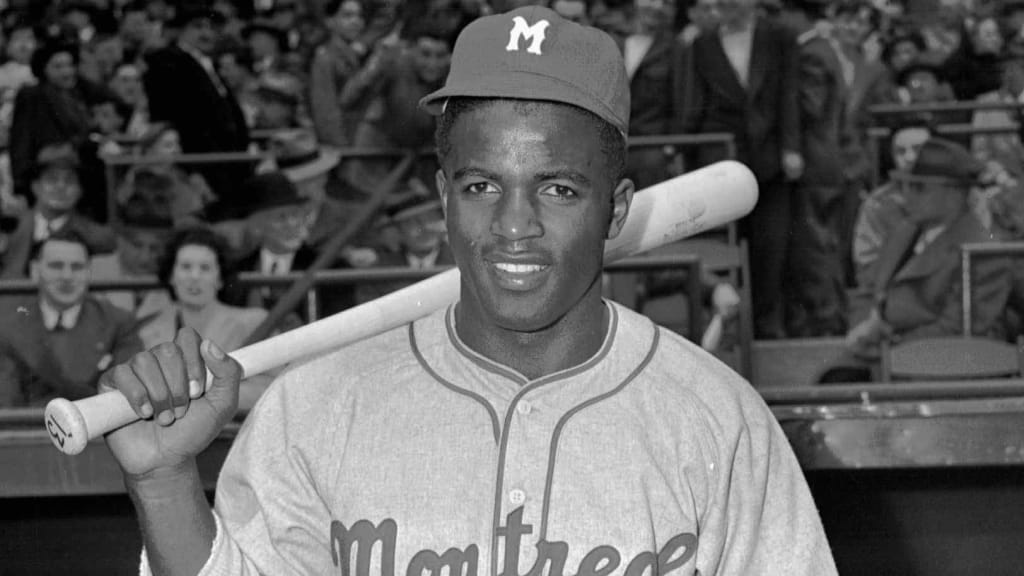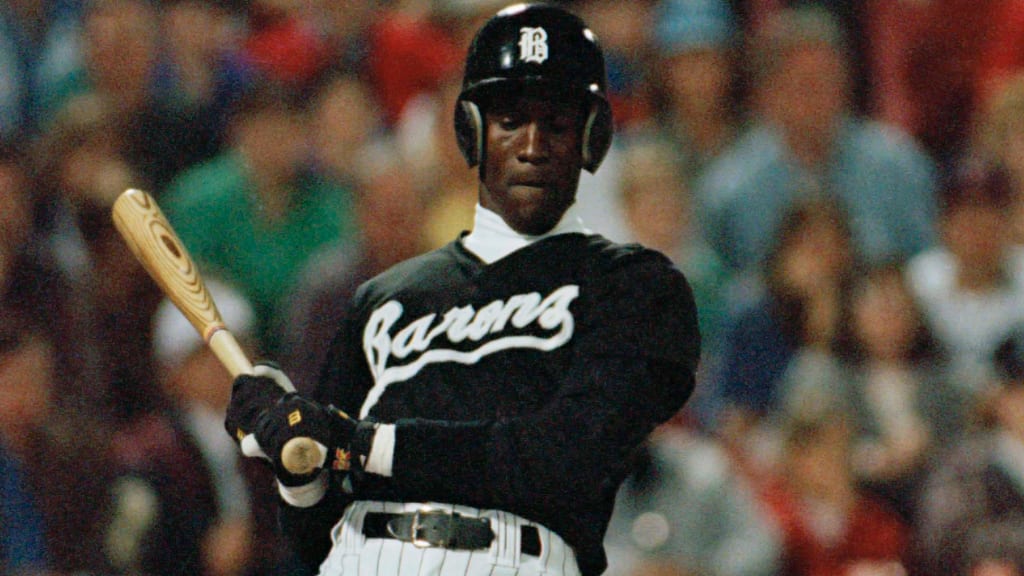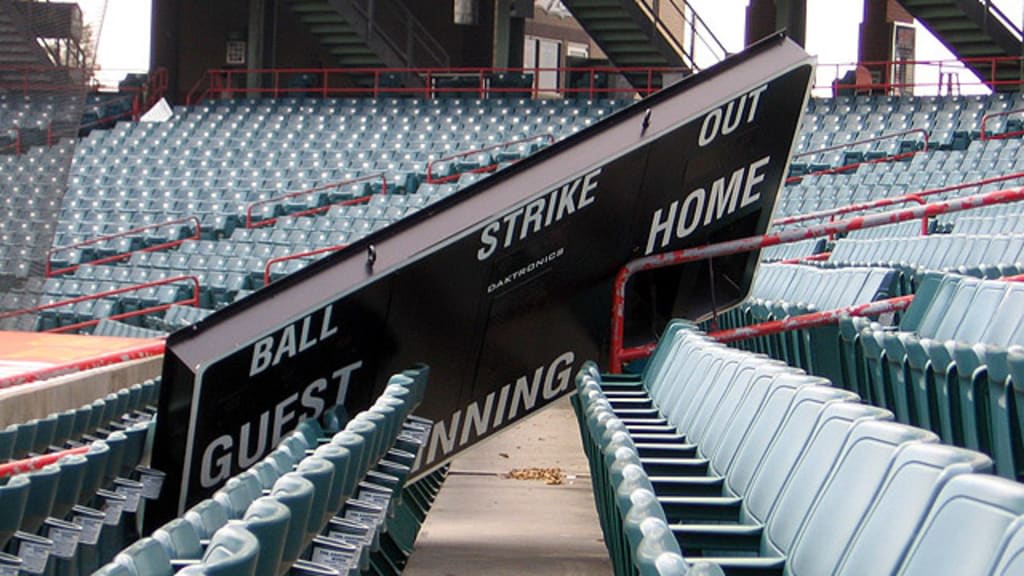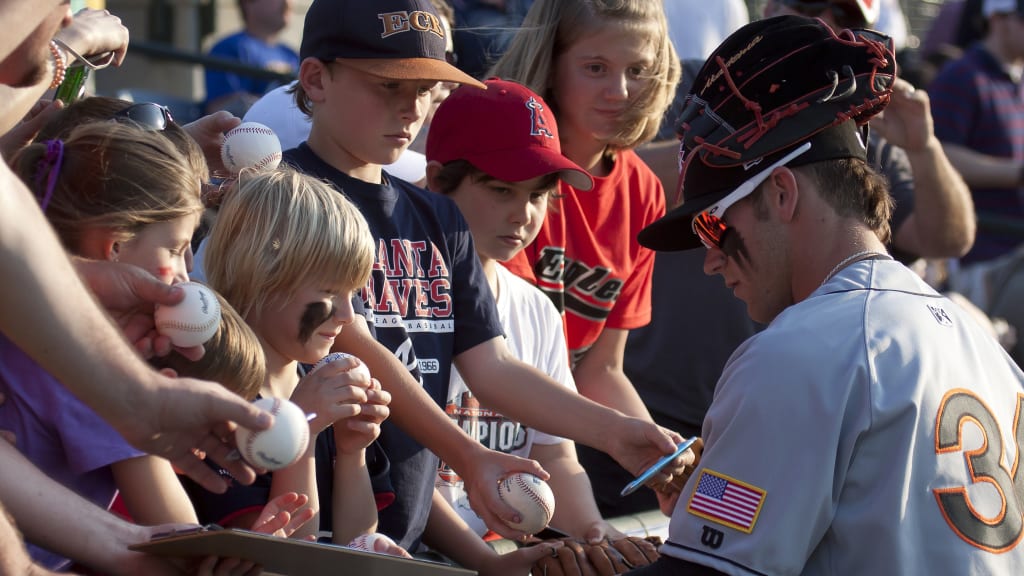
Finally, we have Minor League Baseball again. After a season of alternate training sites, social distancing and silence, Minors parks are ready to welcome the game and its fans once more. These circumstances make Opening Night 2021 even more dramatically anticipated than usual, and one of a significance that reaches beyond baseball.
Whatever happens on any ballfield on Tuesday night, this opening is guaranteed to take a place in history among others that were harbingers of a return to normalcy or changed the Minors for good.
Here are the stories of a few of those openings, presented with the certainty that we’ll appreciate this year’s just as much.
1902: Mud Hens, Saints and all the rest
On April 23, 1902, teams from eight cities inaugurated a new American Association, which the press assured fans in the Midwest was “second only to the National and American League,” with players "who will give first-class ball.” In some ways, this was the birth of an antecedent to Triple-A baseball.
And although the lineage is indirect, the teams playing that day will sound familiar to anybody following the Triple-A East tonight. Columbus beat Minneapolis, 5-0, and Louisville fell to Kansas City, 16-6. The Toledo Mud Hens took 11 innings to get past the St. Paul Saints, 11-7. Indianapolis hosted a parade featuring both the hometown Indians (who went on to win the whole shebang) and the visiting Brewers. The Indianapolis Military Band played, and Mayor Charles A. Bookwalter threw out the first ball and gave a playful speech addressing the Milwaukee nine as “ye sons of Pabst and Schlitz.” A crowd of 3,500 was on hand as Indianapolis won, 5-4.
1918: After the war, and the pandemic
Imagine, if you can, the excitement of MiLB starting again after a year lost to tragic global events. The vast majority of Minors circuits stopped the 1918 season due to World War I travel restrictions and a “Work or Fight” directive, with the 1918 Flu Pandemic spreading in the summer and kicking into high gear in the fall. To understand the impact of this double catastrophe on baseball, let’s go back to the American Association. Saints catcher Harry Glenn, who was drafted into the Army before the AA campaign was called, died at a St. Paul training camp in October. He was one of 195,000 Americans taken by the ’18 Flu that month.
After such a dark and weighty layoff, fans embraced Opening Day across the Minor League landscape. In the Texas League, the Galveston Pirates beat the Beaumont Oilers, 5-4, in what the Galveston Daily News described as a “sensational opener.”
“The outlook for baseball was never rosier…” the paper reported. “Old-time fans who long since had forgotten where the ball park stood suddenly pulled themselves out of their hiding places, dusted off their clothes, washed off their 1918 straw hats and yelled – ‘Let’s go!’”
In the Pacific Coast League, the scene was much the same. The Oakland Tribune described fans “lined around the block” to buy tickets three days before the season started and quoted Oaks president J. Cal Ewing as saying, “Baseball has come back, and it is going to be the biggest year the Coast League ever had.”
And he was right, kind of.
1946: Jackie arrives

April 15 lives on as Jackie Robinson Day, a celebration of the date Robinson integrated Major League Baseball. But before that, he integrated the Minors. On April 18, 1946, the 27-year-old infielder suited up for the International League’s Montreal Royals at Roosevelt Stadium in New Jersey and led his club to a 14-1 rout of the Jersey City Giants. In a 4-for-5 performance, Robinson hit a three-run homer, plated four, stole two bases and scored four runs. He also twice goaded opposing pitchers into balking, once getting a free trot home.
The New York Times noted that the Opening Day atmosphere included “the usual pomp and ceremony, a troupe of tumblers and two bands participating in the pre-game festivities,” but took on a much more special quality as the afternoon wore on. “The crowd, a mere quorum of 51,872 … had greeted Robinson warmly but with no wild enthusiasm when he strode to the plate for the first time to ground out, short to first. But when the game was over, he was virtually mobbed on the field.”
Robinson felt the promise of the moment as much as anybody. In “My Own Story,” he wrote with Wendell Smith, "We all sensed that history was in the making, that the long ban against Negro players was about to come crashing down, setting up reverberations that would echo across a continent and perhaps around the world. I believe everyone in Roosevelt Stadium that day realized that he was witnessing a significant collapse in the ancient wall of prejudice."
1946: Another homecoming
Of course, Opening Day 1946 was cherished more than usual even in Minors parks thousands of miles away from where Robinson made his mark. Throughout America’s involvement in World War II, leagues were delayed, abbreviated, canceled, disbanded or all of the above. For baseball fans of all ages, that spring brought a dramatic change from the tensions and stresses of wartime.
On April 18, 1946 in Augusta, Georgia (where tonight Atlanta's Low-A affiliate opens its season), a crowd of 3,500 turned out to see their Tigers beat Charleston, 5-1. Dick Starr, who served in the Army for the last three years of the war, struck out 15.
The Majors welcomed home from service future Hall of Famers like Hank Greenberg, Joe DiMaggio, Ted Williams, Bob Feller and Stan Musial. Less celebrated are the contributions of players who gave years of their Minor League careers to fight. (Some gave their lives; Billy Hebert, who played for the 1941 Merced Bears in the California League, was the first professional ballplayer killed in action.) War’s end, of course, did not mean every player who’d been a promising prospect before the disruption could pick up a glove and start collecting paychecks for playing ball. A lucky few, like Starr, did.
As did Joe Damato. Chicago-born Damato finished the 1942 Wisconsin State League season at age 20 and enlisted in the Army, then was reportedly injured during the Siege of Bastogne and taken prisoner. Back on American soil for the April 28, 1946, grand reopening of the Three-I League, Damato hit a three-run homer in Davenport’s 18-2 trouncing of Quincy. He played a total of 12 Minor League seasons -- four with Nashville.
1994: The 31-year-old hot prospect

For most people involved in the Southern League, the 1994 season began on Thursday, April 7, 1994. As far as the rest of the world was concerned, it began the next night. After a long offseason filled with fan speculation and anticipation, Michael Jordan, having missed the first game to play for the White Sox in an exhibition against the Cubs, suited up for the Birmingham Barons.
In front of a crowd of 10,359, Jordan debuted in right field and went 0-for-3 with a pair of strikeouts. Aside from booing home-plate umpire Lazaro Diaz at each strike called against Jordan, the fans seemed happy just to see M.J. play. They cheered loudly each time he came to the dish and for each of his four catches in the outfield.
“I’ve got Michael Jordan all over my room,” 15-year-old Brandon Haynes of nearby Pinson, Alabama, told the Scripps Howard News Service. “As soon as I heard Michael Jordan was going to be with the Barons, I called my grandmother and told her to get us some tickets.”
The excitement never died through the rest of Jordan’s time with Birmingham.
2006: The Zephyrs’ moment in the sun

New Orleans, sweltering and humid in the summer and filled with world-famous entertainment options, isn't known as a baseball town. Often, business was hard for Minors teams in the Big Easy. In the summer of 2005, a fairly good year, the Triple-A Zephyrs drew an average of about 5,000 per home game in a league where the top-attended teams were averaging over 10,000.
The next spring, though, the Zephyrs made an outsized impact on their community. After Hurricane Katrina devastated the region at the end of the previous August, the Triple-A baseball club based in the suburb of Metairie became the first New Orleans professional sports team to resume at home. Although Louisianans were still recovering from the manifold damages of Katrina, 11,006 – a sellout crowd – came to the ballpark on April 6, 2006.
"Even on Opening Day [2006], the roof wasn't completely repaired -- there was still some damage," Mike Schline, the former general manager of the Zephyrs, told Benjamin Hill ahead of the 10-year anniversary of the storm. "The players were emotional, the crowd was awesome, and beautiful weather.
"To get to that day was a great accomplishment. Where we came from Aug. 29, a city in ruins, to our stadium on April 6, is something that we were very proud of."
2011: Harper mania

After Stephen Strasburg in 2010 set the scene, Bryce Harper’s 2011 arrival firmly planted the baseball world in a new era of prospect love. Here came an 18-year-old kid who’d enrolled in community college two years early in order to go pro sooner.
“It’s what I’ve wanted since I was 7 years old,” Harper told the press after the Nationals made him the No. 1 overall pick of the 2010 Draft.
Baseball fans began to feel that they’d been waiting that whole time, too. When he appeared in his first regular-season game on Opening Day for Class A Hagerstown at Rome, Georgia, on April 7, 2011, the story was covered not only by national sports media outlets and in the Washington Post, but in the pages of newspapers in Manitoba, Canada; Port Arthur, Texas and Janesville, Wisconsin.
Playing before a crowd of 4,133, the kid with monstrous power subverted expectations with a bit of small ball. He was 2-for-4 with a stolen base, and one of his singles was a bunt down the third-base line.
